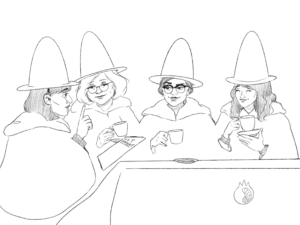Footnotes:

In 1811, Mary Anning made her first fossil discovery at the age of 12, in the town of Lyme Regis in Dorset, England. Today, the area is better known as the Jurassic Coast.



The discovery instilled in Mary a fascination with the mysteries of prehistory. She taught herself everything she could about geology and the natural world, and by the time she was 30, she had unearthed more prehistoric creatures than most of her male contemporaries. However, Mary was a female scientist in a world where science was dominated (even moreso than it is today) by wealthy men. Each new find she presented was met with doubt and distrust. She went uncredited for nearly all of her discoveries for years, decades, and in some cases even centuries. Here’s a look at a few of her most famous fossil finds:
Ichthyosaurs

Mary Anning’s first big discovery was the skeleton of the first-known ichthyosaur, a name meaning “fish lizard.” These creatures were not dinosaurs but rather reptiles that adapted to life in the sea, their feet and tails transforming into fins and paddles over time. Ichthyosaurs are one of the strongest biological examples of convergent evolution, the idea that unrelated lineages of animals will sometimes independently develop similar features to perform a specific function in a given environment. Ichthyosaurs looked quite similar to today’s dolphins and whales, and they filled pretty much the same niche in the open oceans of the Triassic to Late Cretaceous.

There were many varieties of ichthyosaur. Mary Anning’s find was specifically a Temnodontosaurus platydon, one of the largest varieties of ichthyosaur and thought to have the largest eyes of any animal ever recorded. The skeleton she unearthed was 17 feet in length, but temnodontosaurs that grew as long as 39 feet have been discovered since.

Plesiosaurs

Mary Anning’s next major find was a second marine reptile called Plesiosaurus dolichodeirus. It was a creature with a tiny head, but a neck that was as long the rest of its entire turtle-like body from shoulder to tail. You might recognize this animal, as it often gets associated with tales of living dinosaurs and lake monsters, such as the Loch Ness Monster.

In Mary’s day, however. No one had ever seen anything like it, and some of her contemporaries believed it could be a hoax. However, Mary’s discovery of several more near-complete skeletons including Plesiosaurus macrocephalus, a second variety of plesiosaur, left no room for doubt that she’d discovered an extinct creature.

Plesiousaurus lived alongside the ichthyosaurs, swimming the oceans and feasting on fish and belemnites: armored, prehistoric relatives of the modern squid. Today, “plesiosauria” is considered a junk taxon, as several creatures fitting the body plan but too different anatomically to fall into one category have been discovered and lumped in together. Plesiosaurus macrocephalus is one such animal. It exists without an official genus name.

Coprolites

After discovering a few different ichthyosaurs, Mary Anning was beginning to notice that some of the specimens had strange stones in their abdominal regions. Initially, these were called bezoar stones, thought to be fossilized food masses in the creatures’ stomachs. However, after cutting one open, Mary found small, soft fossil fish bones and other ichthyosaur bones within the bezoar stones. She concluded that what she was actually looking at was fossilized feces.
Today, we call these coprolites. Mary Anning’s discovery of fossil poop revealed that there was cannibalism present among ichthyosaurs and other prehistoric marine reptiles. Her coprolites helped to usher in the study of trace fossils, as scientists began to understand that sometimes what animals leave behind is just as important as their bones or bodies when it comes to understanding how they lived.

Prehistoric Fish

In 1822, Mary discovered a type of odd fossilized fish embedded in the Lyme Regis cliffs. The fish had bony plates on its head and around its eyes, a jaw that could protrude from its mouth for wider gape, and fins on the upper and lower sides of its body that formed a single unit with its tale. The creature, Dapedium politum, would turn out to be a primitive ancestor of ray-finned fish.
A few years later in 1828, Mary would discover another fossil fish called Squaloraja polyspondyla. She noted that this creature appeared to have a body plan like a shark, with a large protuberance on its face like a sawfish, but with ray-like fins along its body. In fact, the creature would turn out to be an intermediate step on the evolutionary ladder between sharks and rays. Recall, though, that this was a time when extinction was a novel concept and evolution was still to come. Squaloraja made a case for both theories.

Pterosaur

In late 1828, Mary discovered what some initially thought might be the skeleton of a bat-winged vampire. The creature was actually determined to be a type of pterosaur, though not the first ever discovered. That honor goes to Pterodactylus antiquus, though Mary’s find was designated as a type of pterodactyl. The creature would later be described and named by Richard Owen as Dimorphodon macronyx.

Like marine reptiles, pterosaurs are not dinosaurs. They’re reptiles that developed wings and adapted to life in the air, filling the niche we see modern birds occupying today. Though pterosaurs had been discovered previously, Mary’s discovery put the creatures into a context. When taken with the fish and marine reptiles she had discovered, scientists started seeing the larger picture: a bygone world with predatory leviathans beneath the waves and strange reptiles flying through the air, hunting and fishing along the beaches. This is perhaps best demonstrated by Henry De la Beche’s painting Duria Antiquior, meaning “A more ancient Dorset,” which was the first attempt to depict prehistoric geological time.

In spite of all these incredible contributions to the field of paleontology, Mary Anning has been largely forgotten by science. She received little or no recognition for these discoveries in her lifetime, and instead spent her days selling polished ammonites, belemnites, and other fossils to tourists on the beaches of her hometown. Terry Sullivan’s famous tongue-twister, “She Sells Seashells by the Seashore,” is said to be based on her modest little business:
She sells sea-shells on the sea-shore.
The shells she sells are sea-shells, I’m sure.
For if she sells sea-shells on the sea-shore
Then I’m sure she sells sea-shore shells.

Sources:
Fossil hunter Mary Anning celebrated in Lyme Regis by BBC News
Mary Anning of Lyme Regis: 19th Century Pioneer in British Palaeontology by Larry E. Davis
Mary Anning (1799-1847) by The Geological Society of London
Mary Anning by StrangeScience.net
She Sells Seashells By Bill Marray 1909
Museum Management:
Museum theme by Michael Guy Bowman
Listen to more at: bowman.bandcamp.com
Rachel: Designer #UkuleleWitch @rachelvice
Tour Guide: Emery Coolcats
Twitter: @natmysterycast | Email: natmysterypodcast@gmail.com | Home: https://pomemag.wpengine.com/tag/museum-of-natural-mystery/
Museum of Natural Mystery is part of the POMEcast network, and thanks a million to the ladies of POME for helping this show get up and running! But above all, thank you for listening! We’ll see you next time!




